Leadership for Managers Reflection of Learnings - Semester Report
VerifiedAdded on 2023/06/08
|9
|2630
|145
Report
AI Summary
This report is a reflective journal exploring leadership concepts and theories, drawing from the course 'Leadership for Managers.' The student delves into various leadership styles, including autocratic, democratic, laissez-faire, transformational, transactional, and bureaucratic approaches, analyzing their strengths and weaknesses. The report also examines the significance of leadership qualities, such as intelligence, integrity, and self-confidence, and emphasizes the importance of building and maintaining relationships within organizations. The student reflects on the evolution of leadership, the impact of communication skills, and the necessity for leaders to adapt to changing times. The report further highlights the importance of effective communication, active listening, and the ability to motivate teams. Drawing from course materials and personal experiences, the student discusses the practical application of leadership principles in achieving organizational goals and fostering team success, emphasizing the value of creativity, freedom, and empathetic leadership.

Running head: Leadership for Managers
Leadership For Managers
Reflection of the Learnings
Leadership For Managers
Reflection of the Learnings
Paraphrase This Document
Need a fresh take? Get an instant paraphrase of this document with our AI Paraphraser
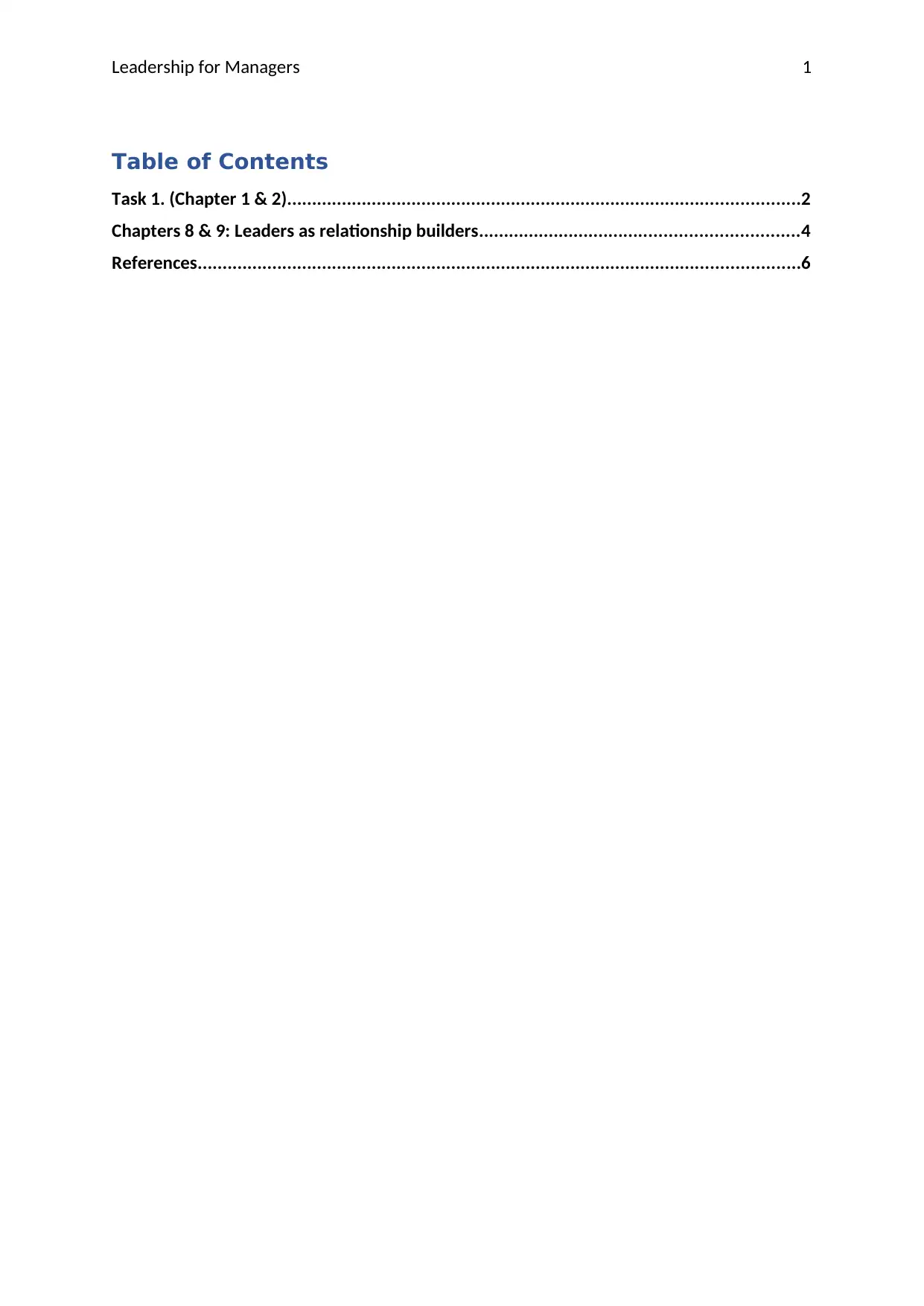
Leadership for Managers
Table of Contents
Task 1. (Chapter 1 & 2).......................................................................................................2
Chapters 8 & 9: Leaders as relationship builders................................................................4
References.........................................................................................................................6
1
Table of Contents
Task 1. (Chapter 1 & 2).......................................................................................................2
Chapters 8 & 9: Leaders as relationship builders................................................................4
References.........................................................................................................................6
1
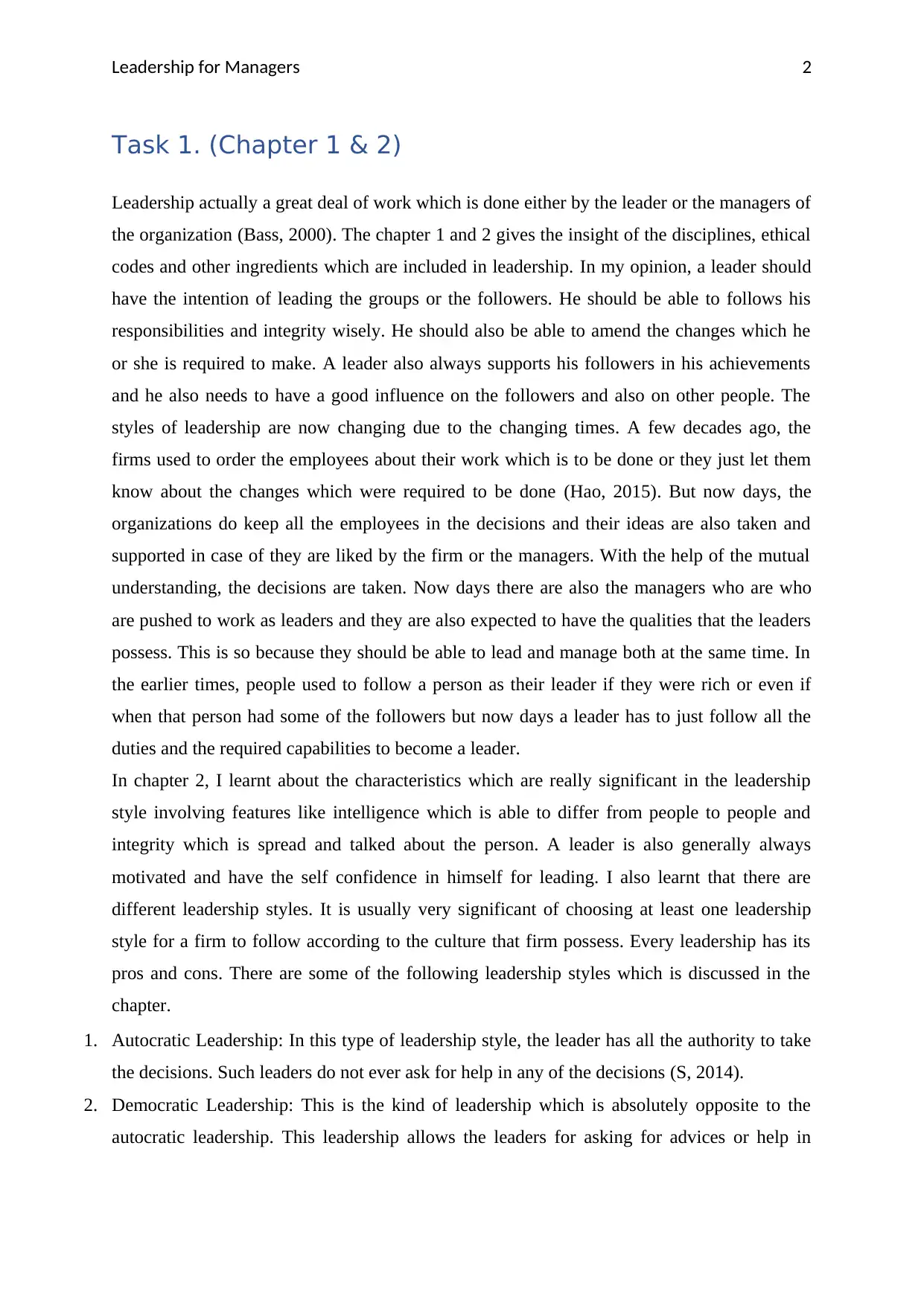
Leadership for Managers
Task 1. (Chapter 1 & 2)
Leadership actually a great deal of work which is done either by the leader or the managers of
the organization (Bass, 2000). The chapter 1 and 2 gives the insight of the disciplines, ethical
codes and other ingredients which are included in leadership. In my opinion, a leader should
have the intention of leading the groups or the followers. He should be able to follows his
responsibilities and integrity wisely. He should also be able to amend the changes which he
or she is required to make. A leader also always supports his followers in his achievements
and he also needs to have a good influence on the followers and also on other people. The
styles of leadership are now changing due to the changing times. A few decades ago, the
firms used to order the employees about their work which is to be done or they just let them
know about the changes which were required to be done (Hao, 2015). But now days, the
organizations do keep all the employees in the decisions and their ideas are also taken and
supported in case of they are liked by the firm or the managers. With the help of the mutual
understanding, the decisions are taken. Now days there are also the managers who are who
are pushed to work as leaders and they are also expected to have the qualities that the leaders
possess. This is so because they should be able to lead and manage both at the same time. In
the earlier times, people used to follow a person as their leader if they were rich or even if
when that person had some of the followers but now days a leader has to just follow all the
duties and the required capabilities to become a leader.
In chapter 2, I learnt about the characteristics which are really significant in the leadership
style involving features like intelligence which is able to differ from people to people and
integrity which is spread and talked about the person. A leader is also generally always
motivated and have the self confidence in himself for leading. I also learnt that there are
different leadership styles. It is usually very significant of choosing at least one leadership
style for a firm to follow according to the culture that firm possess. Every leadership has its
pros and cons. There are some of the following leadership styles which is discussed in the
chapter.
1. Autocratic Leadership: In this type of leadership style, the leader has all the authority to take
the decisions. Such leaders do not ever ask for help in any of the decisions (S, 2014).
2. Democratic Leadership: This is the kind of leadership which is absolutely opposite to the
autocratic leadership. This leadership allows the leaders for asking for advices or help in
2
Task 1. (Chapter 1 & 2)
Leadership actually a great deal of work which is done either by the leader or the managers of
the organization (Bass, 2000). The chapter 1 and 2 gives the insight of the disciplines, ethical
codes and other ingredients which are included in leadership. In my opinion, a leader should
have the intention of leading the groups or the followers. He should be able to follows his
responsibilities and integrity wisely. He should also be able to amend the changes which he
or she is required to make. A leader also always supports his followers in his achievements
and he also needs to have a good influence on the followers and also on other people. The
styles of leadership are now changing due to the changing times. A few decades ago, the
firms used to order the employees about their work which is to be done or they just let them
know about the changes which were required to be done (Hao, 2015). But now days, the
organizations do keep all the employees in the decisions and their ideas are also taken and
supported in case of they are liked by the firm or the managers. With the help of the mutual
understanding, the decisions are taken. Now days there are also the managers who are who
are pushed to work as leaders and they are also expected to have the qualities that the leaders
possess. This is so because they should be able to lead and manage both at the same time. In
the earlier times, people used to follow a person as their leader if they were rich or even if
when that person had some of the followers but now days a leader has to just follow all the
duties and the required capabilities to become a leader.
In chapter 2, I learnt about the characteristics which are really significant in the leadership
style involving features like intelligence which is able to differ from people to people and
integrity which is spread and talked about the person. A leader is also generally always
motivated and have the self confidence in himself for leading. I also learnt that there are
different leadership styles. It is usually very significant of choosing at least one leadership
style for a firm to follow according to the culture that firm possess. Every leadership has its
pros and cons. There are some of the following leadership styles which is discussed in the
chapter.
1. Autocratic Leadership: In this type of leadership style, the leader has all the authority to take
the decisions. Such leaders do not ever ask for help in any of the decisions (S, 2014).
2. Democratic Leadership: This is the kind of leadership which is absolutely opposite to the
autocratic leadership. This leadership allows the leaders for asking for advices or help in
2
⊘ This is a preview!⊘
Do you want full access?
Subscribe today to unlock all pages.

Trusted by 1+ million students worldwide
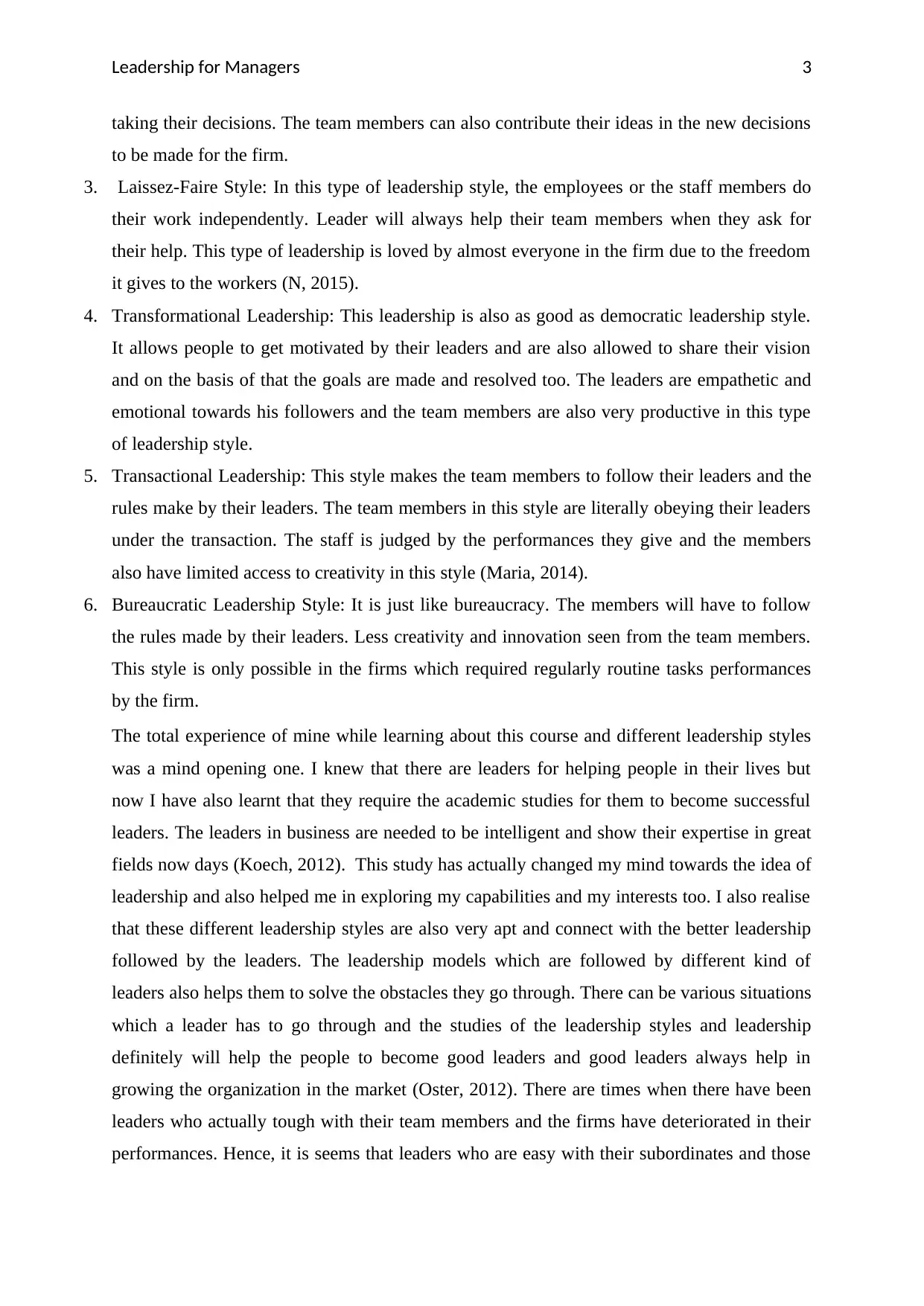
Leadership for Managers
taking their decisions. The team members can also contribute their ideas in the new decisions
to be made for the firm.
3. Laissez-Faire Style: In this type of leadership style, the employees or the staff members do
their work independently. Leader will always help their team members when they ask for
their help. This type of leadership is loved by almost everyone in the firm due to the freedom
it gives to the workers (N, 2015).
4. Transformational Leadership: This leadership is also as good as democratic leadership style.
It allows people to get motivated by their leaders and are also allowed to share their vision
and on the basis of that the goals are made and resolved too. The leaders are empathetic and
emotional towards his followers and the team members are also very productive in this type
of leadership style.
5. Transactional Leadership: This style makes the team members to follow their leaders and the
rules make by their leaders. The team members in this style are literally obeying their leaders
under the transaction. The staff is judged by the performances they give and the members
also have limited access to creativity in this style (Maria, 2014).
6. Bureaucratic Leadership Style: It is just like bureaucracy. The members will have to follow
the rules made by their leaders. Less creativity and innovation seen from the team members.
This style is only possible in the firms which required regularly routine tasks performances
by the firm.
The total experience of mine while learning about this course and different leadership styles
was a mind opening one. I knew that there are leaders for helping people in their lives but
now I have also learnt that they require the academic studies for them to become successful
leaders. The leaders in business are needed to be intelligent and show their expertise in great
fields now days (Koech, 2012). This study has actually changed my mind towards the idea of
leadership and also helped me in exploring my capabilities and my interests too. I also realise
that these different leadership styles are also very apt and connect with the better leadership
followed by the leaders. The leadership models which are followed by different kind of
leaders also helps them to solve the obstacles they go through. There can be various situations
which a leader has to go through and the studies of the leadership styles and leadership
definitely will help the people to become good leaders and good leaders always help in
growing the organization in the market (Oster, 2012). There are times when there have been
leaders who actually tough with their team members and the firms have deteriorated in their
performances. Hence, it is seems that leaders who are easy with their subordinates and those
3
taking their decisions. The team members can also contribute their ideas in the new decisions
to be made for the firm.
3. Laissez-Faire Style: In this type of leadership style, the employees or the staff members do
their work independently. Leader will always help their team members when they ask for
their help. This type of leadership is loved by almost everyone in the firm due to the freedom
it gives to the workers (N, 2015).
4. Transformational Leadership: This leadership is also as good as democratic leadership style.
It allows people to get motivated by their leaders and are also allowed to share their vision
and on the basis of that the goals are made and resolved too. The leaders are empathetic and
emotional towards his followers and the team members are also very productive in this type
of leadership style.
5. Transactional Leadership: This style makes the team members to follow their leaders and the
rules make by their leaders. The team members in this style are literally obeying their leaders
under the transaction. The staff is judged by the performances they give and the members
also have limited access to creativity in this style (Maria, 2014).
6. Bureaucratic Leadership Style: It is just like bureaucracy. The members will have to follow
the rules made by their leaders. Less creativity and innovation seen from the team members.
This style is only possible in the firms which required regularly routine tasks performances
by the firm.
The total experience of mine while learning about this course and different leadership styles
was a mind opening one. I knew that there are leaders for helping people in their lives but
now I have also learnt that they require the academic studies for them to become successful
leaders. The leaders in business are needed to be intelligent and show their expertise in great
fields now days (Koech, 2012). This study has actually changed my mind towards the idea of
leadership and also helped me in exploring my capabilities and my interests too. I also realise
that these different leadership styles are also very apt and connect with the better leadership
followed by the leaders. The leadership models which are followed by different kind of
leaders also helps them to solve the obstacles they go through. There can be various situations
which a leader has to go through and the studies of the leadership styles and leadership
definitely will help the people to become good leaders and good leaders always help in
growing the organization in the market (Oster, 2012). There are times when there have been
leaders who actually tough with their team members and the firms have deteriorated in their
performances. Hence, it is seems that leaders who are easy with their subordinates and those
3
Paraphrase This Document
Need a fresh take? Get an instant paraphrase of this document with our AI Paraphraser

Leadership for Managers
who allow lots of creativity and freedom to give to their subordinates, those leaders are more
successful and popular with the firms as well as the team members also love them (Nawaz &
Ahmed, 2016).
Chapters 8 & 9: Leaders as relationship builders
The necessary feature of being a leader is that one can lead others in making them achieve
their own and firm’s goals. There is also one more characteristics of leaders and that is to
build and maintain the relations with other people in the firm. For any growth of the firm,
maintaining the relationship is the most effective element which the leaders should possess
(Luthra & Dahiya , 2015). In the book, “The Leadership Challenge” an elaborative deep
understanding of leadership is given. There only I came to know about the relationship of the
leader and how to maintain it. It was very clear from that book that it is really significant to
have good and effective relationships so that they are able to help in the development of the
goals and unswerving purpose in order to put all the energies of the team and staff in
directing towards achieving the goals. A great leader would be capable of focussing on the
relationship building with the people whom they he leads or put simply his followers. It
becomes evident to me that a leader in building good and effective leaderships, follow some
simple steps with their team members. They are as follows:
They listen very attentively what others are saying. They take proactive steps to
remove any distractions so that conversations can be fruitful (Abbasi & Siddiqi,
2011).
They give appropriate value to opinion of others.
They always applaud and acknowledge the contributions of others.
Leaders should always be good in communicating too. With good communication, they can
easily connect with people and relate with them and make them achieve the goals not just in
personal life but also in professional life. Leaders with good communication are always great
in their work. They are always able to motivate the staff (Terek, Glušac, & Nikolic, 2015).
They communicate in a nice way and always have a clear-cut point with what they want
people to achieve. They have very specific ideas, goals, values and principles. For having
these elements in a clear-cut way, the communication should be two way. There should be a
4
who allow lots of creativity and freedom to give to their subordinates, those leaders are more
successful and popular with the firms as well as the team members also love them (Nawaz &
Ahmed, 2016).
Chapters 8 & 9: Leaders as relationship builders
The necessary feature of being a leader is that one can lead others in making them achieve
their own and firm’s goals. There is also one more characteristics of leaders and that is to
build and maintain the relations with other people in the firm. For any growth of the firm,
maintaining the relationship is the most effective element which the leaders should possess
(Luthra & Dahiya , 2015). In the book, “The Leadership Challenge” an elaborative deep
understanding of leadership is given. There only I came to know about the relationship of the
leader and how to maintain it. It was very clear from that book that it is really significant to
have good and effective relationships so that they are able to help in the development of the
goals and unswerving purpose in order to put all the energies of the team and staff in
directing towards achieving the goals. A great leader would be capable of focussing on the
relationship building with the people whom they he leads or put simply his followers. It
becomes evident to me that a leader in building good and effective leaderships, follow some
simple steps with their team members. They are as follows:
They listen very attentively what others are saying. They take proactive steps to
remove any distractions so that conversations can be fruitful (Abbasi & Siddiqi,
2011).
They give appropriate value to opinion of others.
They always applaud and acknowledge the contributions of others.
Leaders should always be good in communicating too. With good communication, they can
easily connect with people and relate with them and make them achieve the goals not just in
personal life but also in professional life. Leaders with good communication are always great
in their work. They are always able to motivate the staff (Terek, Glušac, & Nikolic, 2015).
They communicate in a nice way and always have a clear-cut point with what they want
people to achieve. They have very specific ideas, goals, values and principles. For having
these elements in a clear-cut way, the communication should be two way. There should be a
4
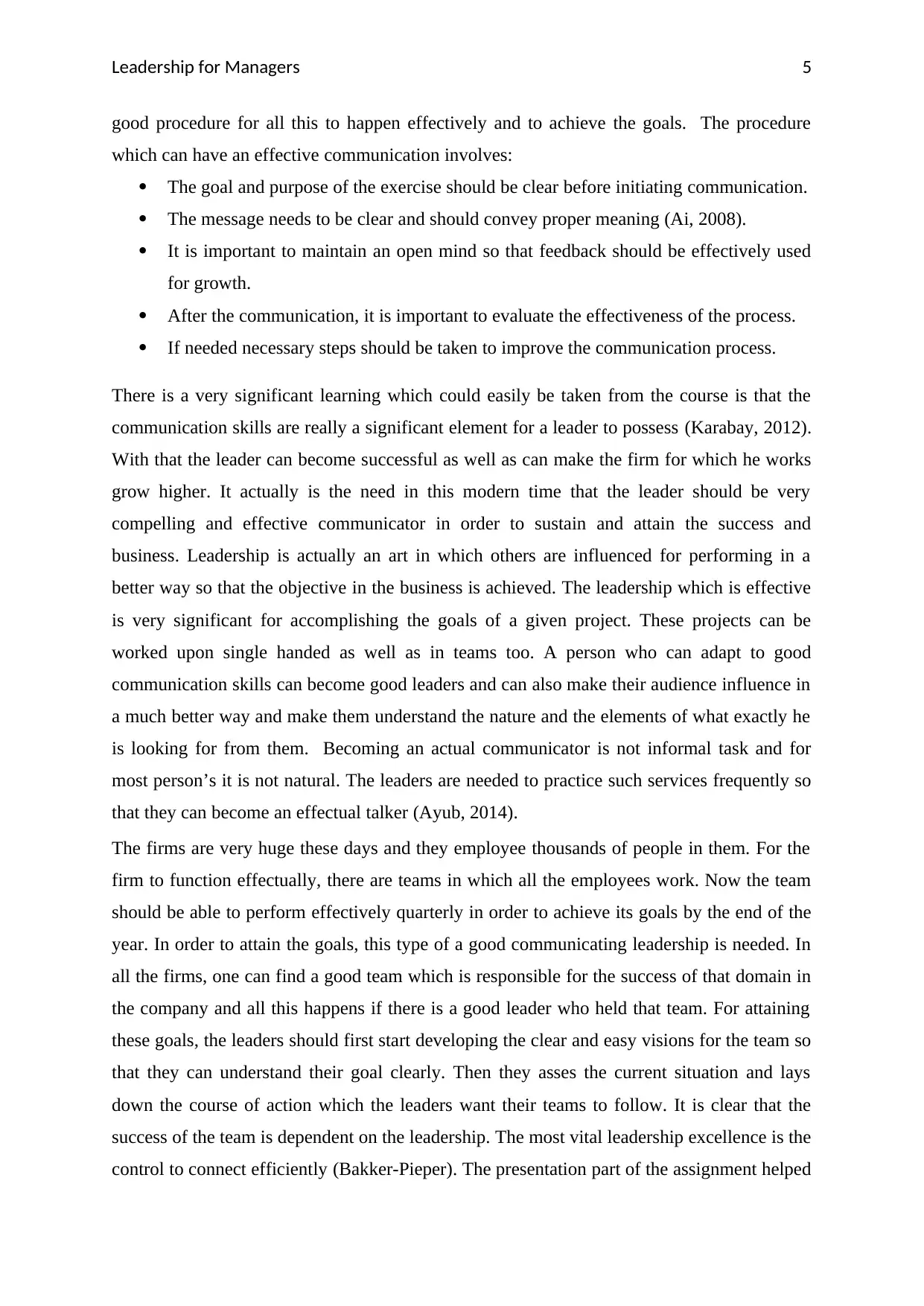
Leadership for Managers
good procedure for all this to happen effectively and to achieve the goals. The procedure
which can have an effective communication involves:
The goal and purpose of the exercise should be clear before initiating communication.
The message needs to be clear and should convey proper meaning (Ai, 2008).
It is important to maintain an open mind so that feedback should be effectively used
for growth.
After the communication, it is important to evaluate the effectiveness of the process.
If needed necessary steps should be taken to improve the communication process.
There is a very significant learning which could easily be taken from the course is that the
communication skills are really a significant element for a leader to possess (Karabay, 2012).
With that the leader can become successful as well as can make the firm for which he works
grow higher. It actually is the need in this modern time that the leader should be very
compelling and effective communicator in order to sustain and attain the success and
business. Leadership is actually an art in which others are influenced for performing in a
better way so that the objective in the business is achieved. The leadership which is effective
is very significant for accomplishing the goals of a given project. These projects can be
worked upon single handed as well as in teams too. A person who can adapt to good
communication skills can become good leaders and can also make their audience influence in
a much better way and make them understand the nature and the elements of what exactly he
is looking for from them. Becoming an actual communicator is not informal task and for
most person’s it is not natural. The leaders are needed to practice such services frequently so
that they can become an effectual talker (Ayub, 2014).
The firms are very huge these days and they employee thousands of people in them. For the
firm to function effectually, there are teams in which all the employees work. Now the team
should be able to perform effectively quarterly in order to achieve its goals by the end of the
year. In order to attain the goals, this type of a good communicating leadership is needed. In
all the firms, one can find a good team which is responsible for the success of that domain in
the company and all this happens if there is a good leader who held that team. For attaining
these goals, the leaders should first start developing the clear and easy visions for the team so
that they can understand their goal clearly. Then they asses the current situation and lays
down the course of action which the leaders want their teams to follow. It is clear that the
success of the team is dependent on the leadership. The most vital leadership excellence is the
control to connect efficiently (Bakker-Pieper). The presentation part of the assignment helped
5
good procedure for all this to happen effectively and to achieve the goals. The procedure
which can have an effective communication involves:
The goal and purpose of the exercise should be clear before initiating communication.
The message needs to be clear and should convey proper meaning (Ai, 2008).
It is important to maintain an open mind so that feedback should be effectively used
for growth.
After the communication, it is important to evaluate the effectiveness of the process.
If needed necessary steps should be taken to improve the communication process.
There is a very significant learning which could easily be taken from the course is that the
communication skills are really a significant element for a leader to possess (Karabay, 2012).
With that the leader can become successful as well as can make the firm for which he works
grow higher. It actually is the need in this modern time that the leader should be very
compelling and effective communicator in order to sustain and attain the success and
business. Leadership is actually an art in which others are influenced for performing in a
better way so that the objective in the business is achieved. The leadership which is effective
is very significant for accomplishing the goals of a given project. These projects can be
worked upon single handed as well as in teams too. A person who can adapt to good
communication skills can become good leaders and can also make their audience influence in
a much better way and make them understand the nature and the elements of what exactly he
is looking for from them. Becoming an actual communicator is not informal task and for
most person’s it is not natural. The leaders are needed to practice such services frequently so
that they can become an effectual talker (Ayub, 2014).
The firms are very huge these days and they employee thousands of people in them. For the
firm to function effectually, there are teams in which all the employees work. Now the team
should be able to perform effectively quarterly in order to achieve its goals by the end of the
year. In order to attain the goals, this type of a good communicating leadership is needed. In
all the firms, one can find a good team which is responsible for the success of that domain in
the company and all this happens if there is a good leader who held that team. For attaining
these goals, the leaders should first start developing the clear and easy visions for the team so
that they can understand their goal clearly. Then they asses the current situation and lays
down the course of action which the leaders want their teams to follow. It is clear that the
success of the team is dependent on the leadership. The most vital leadership excellence is the
control to connect efficiently (Bakker-Pieper). The presentation part of the assignment helped
5
⊘ This is a preview!⊘
Do you want full access?
Subscribe today to unlock all pages.

Trusted by 1+ million students worldwide
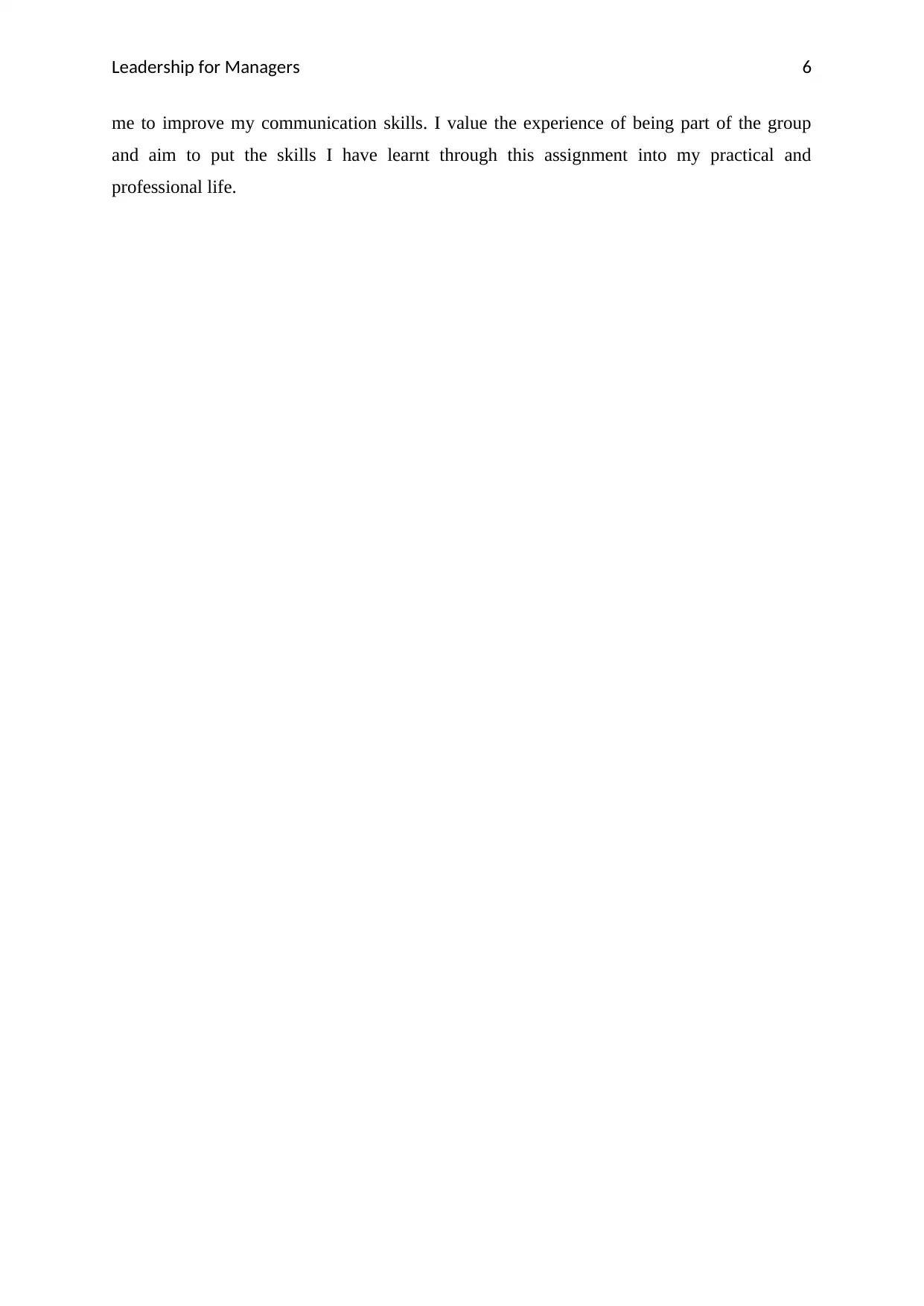
Leadership for Managers
me to improve my communication skills. I value the experience of being part of the group
and aim to put the skills I have learnt through this assignment into my practical and
professional life.
6
me to improve my communication skills. I value the experience of being part of the group
and aim to put the skills I have learnt through this assignment into my practical and
professional life.
6
Paraphrase This Document
Need a fresh take? Get an instant paraphrase of this document with our AI Paraphraser

Leadership for Managers
References
Bass, B. M. (2000). The Future of Leadership in Learning Organizations. Journal of
Leadership & Organizational Studies, 7(8).
Hao, M. J. (2015). How Effective Leadership can Facilitate Change in Organizations through
Improvement and Innovation . Global Journal of Management and Business
Research: A Administration and Management, 15(9).
S, N. T. (2014). Leadership styles. Advances In Management, 7(2).
N, I. (2015). Effect of Leadership Style on Employee Performance. Arabian Journal of
Business and 10.4172/2223-5833.1000146 ar A Management Review , 5(5).
Maria, B. (2014). THE RELATIONSHIP BETWEEN LEADERSHIP EFFECTIVENESS
AND ORGANIZATIONAL PERFORMANCE. Journal of Defence resource
Management, 3(1).
Koech, P. M. (2012). The Effect of Leadership Styles on Organizational Performance at State
Corporations in Kenya. International Journal of Business and Commerce, 2(1).
Oster, G. (2012). Article Abstracts. Journal of Strategic Leadership, 4(1).
Nawaz, A., & Ahmed, Z. (2016). Leadership Theories and Styles: A Literature Review.
Journal of Resources Development and Management, 16.
Luthra, A., & Dahiya , R. (2015). Effective Leadership is all About Communicating
Effectively: Connecting Leadership and Communication. International Journal of
Management & Business Studies, 5(3).
Abbasi , M. H., & Siddiqi, A. (2011). Role of Effective Communications for Enhancing
Leadership and Entrepreneurial Skills in University Students. International Journal of
Business and Social Science, 2(10).
Terek, E., Glušac, D., & Nikolic, M. (2015). The Impact of Leadership on the
Communication Satisfaction of Primary School Teachers in Serbia. Educational
Sciences: Theory and Practices, 15(1), 73-84.
Ai, C. Y. (2008). Relationships between Leadership Communication Practices and
Organisational Commitment in a Selected Higher Education Institution. Pertanika J.
Soc. Sci. & Hum, 16(1), 15-29.
Karabay, M. E. (2012). The Effects of Leadership Styles and the Communication
Competency of Bank Managers on the Employee Job Satisfaction : The Case of
7
References
Bass, B. M. (2000). The Future of Leadership in Learning Organizations. Journal of
Leadership & Organizational Studies, 7(8).
Hao, M. J. (2015). How Effective Leadership can Facilitate Change in Organizations through
Improvement and Innovation . Global Journal of Management and Business
Research: A Administration and Management, 15(9).
S, N. T. (2014). Leadership styles. Advances In Management, 7(2).
N, I. (2015). Effect of Leadership Style on Employee Performance. Arabian Journal of
Business and 10.4172/2223-5833.1000146 ar A Management Review , 5(5).
Maria, B. (2014). THE RELATIONSHIP BETWEEN LEADERSHIP EFFECTIVENESS
AND ORGANIZATIONAL PERFORMANCE. Journal of Defence resource
Management, 3(1).
Koech, P. M. (2012). The Effect of Leadership Styles on Organizational Performance at State
Corporations in Kenya. International Journal of Business and Commerce, 2(1).
Oster, G. (2012). Article Abstracts. Journal of Strategic Leadership, 4(1).
Nawaz, A., & Ahmed, Z. (2016). Leadership Theories and Styles: A Literature Review.
Journal of Resources Development and Management, 16.
Luthra, A., & Dahiya , R. (2015). Effective Leadership is all About Communicating
Effectively: Connecting Leadership and Communication. International Journal of
Management & Business Studies, 5(3).
Abbasi , M. H., & Siddiqi, A. (2011). Role of Effective Communications for Enhancing
Leadership and Entrepreneurial Skills in University Students. International Journal of
Business and Social Science, 2(10).
Terek, E., Glušac, D., & Nikolic, M. (2015). The Impact of Leadership on the
Communication Satisfaction of Primary School Teachers in Serbia. Educational
Sciences: Theory and Practices, 15(1), 73-84.
Ai, C. Y. (2008). Relationships between Leadership Communication Practices and
Organisational Commitment in a Selected Higher Education Institution. Pertanika J.
Soc. Sci. & Hum, 16(1), 15-29.
Karabay, M. E. (2012). The Effects of Leadership Styles and the Communication
Competency of Bank Managers on the Employee Job Satisfaction : The Case of
7
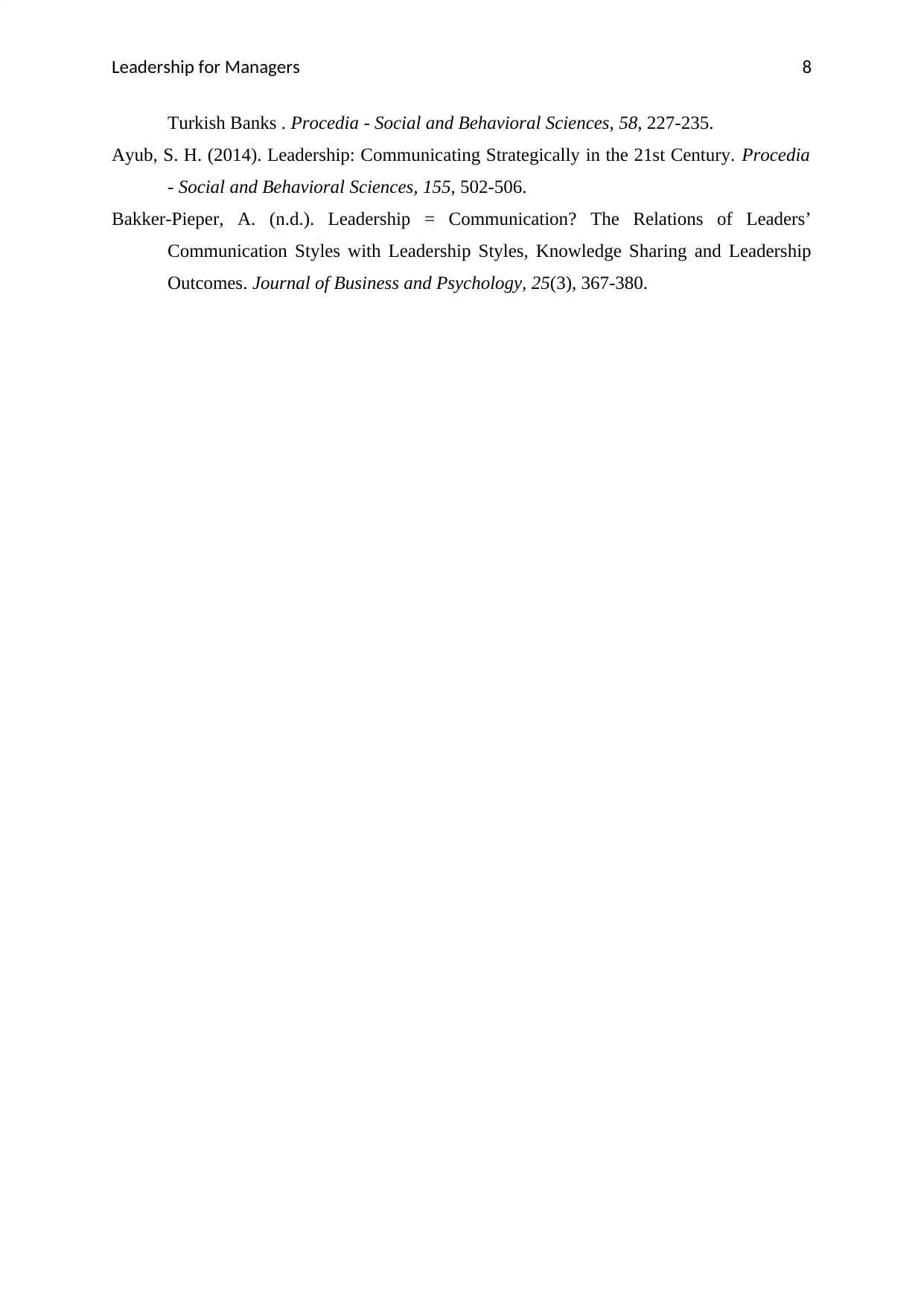
Leadership for Managers
Turkish Banks . Procedia - Social and Behavioral Sciences, 58, 227-235.
Ayub, S. H. (2014). Leadership: Communicating Strategically in the 21st Century. Procedia
- Social and Behavioral Sciences, 155, 502-506.
Bakker-Pieper, A. (n.d.). Leadership = Communication? The Relations of Leaders’
Communication Styles with Leadership Styles, Knowledge Sharing and Leadership
Outcomes. Journal of Business and Psychology, 25(3), 367-380.
8
Turkish Banks . Procedia - Social and Behavioral Sciences, 58, 227-235.
Ayub, S. H. (2014). Leadership: Communicating Strategically in the 21st Century. Procedia
- Social and Behavioral Sciences, 155, 502-506.
Bakker-Pieper, A. (n.d.). Leadership = Communication? The Relations of Leaders’
Communication Styles with Leadership Styles, Knowledge Sharing and Leadership
Outcomes. Journal of Business and Psychology, 25(3), 367-380.
8
⊘ This is a preview!⊘
Do you want full access?
Subscribe today to unlock all pages.

Trusted by 1+ million students worldwide
1 out of 9
Related Documents
Your All-in-One AI-Powered Toolkit for Academic Success.
+13062052269
info@desklib.com
Available 24*7 on WhatsApp / Email
![[object Object]](/_next/static/media/star-bottom.7253800d.svg)
Unlock your academic potential
Copyright © 2020–2025 A2Z Services. All Rights Reserved. Developed and managed by ZUCOL.




